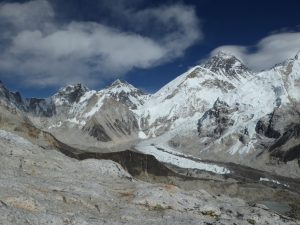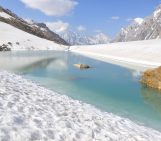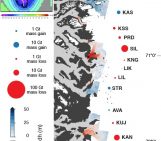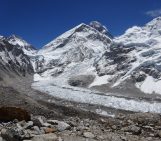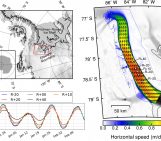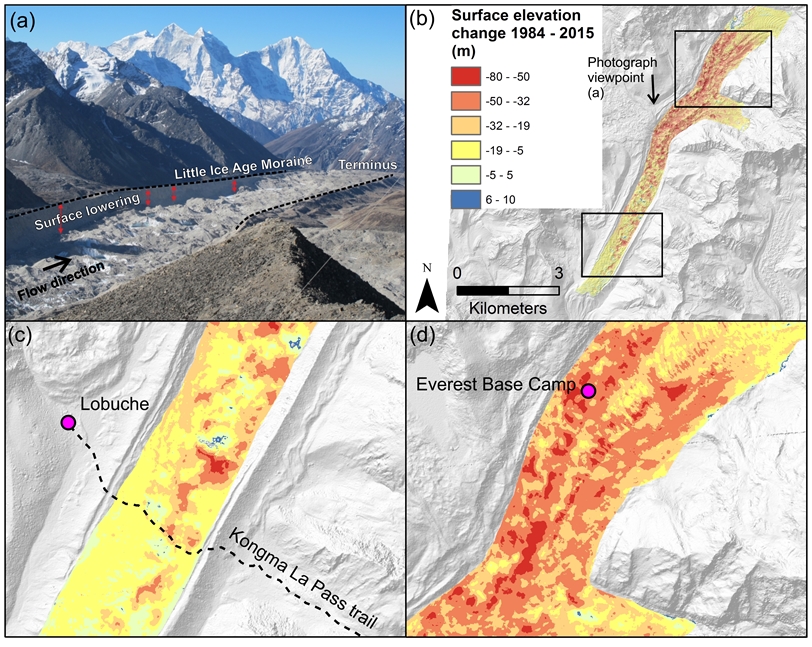
Fig. 1: Surface lowering on the debris-covered Khumbu Glacier, Nepal derived from differencing two digital elevation models. (a) The debris-covered surface looking down-glacier. (b-d) Surface elevation change 1984−2015. [Credit: Scott Watson and Owen King]
From 1984 to 2015, approximately 71,000 Olympic size swimming pools worth of water were released from the melting Khumbu Glacier in Nepal, which is home to Everest Basecamp. Find out how Himalayan glaciers are changing and the implications for downstream communities in this Image of the Week.
Himalayan glaciers supply freshwater
Himalayan glaciers supply meltwater for ~800 million people, including for agricultural, domestic, and hydropower use (Pritchard, 2017). They also alleviate seasonal variations in water supply by providing meltwater during the dry season. This freshwater resource is rapidly depleting as glaciers thin and glacial lakes begin to form (Bolch et al., 2008; Watson et al., 2016; King et al., 2017). Additionally, outburst floods from these lakes (see those previous posts on the topic) threaten downstream impacts for communities and infrastructure (Rounce et al., 2016).
Debris-covered glaciers thin, rather than retreat
Erosion in the rugged mountain topography leads to high quantities of rocky debris accumulating on the glacier surface, which changes the glacial response to climatic warming. The debris-layer (which can be several metres thick at the lower terminus) insulates the ice beneath, leading to highest melt rates up-glacier of the terminus. Therefore these debris-covered glacier thin, rather than retreat up-valley.
This thinning is actually a complex process of sub-debris melt, and mass loss associated with supraglacial ponds and ice cliffs, which form pits on the glacier surface and are ‘hot-spots’ of mass loss. Since the highest rates of surface lowering are up-glacier from the terminus, the surface slope of the glacier reduces and meltwater increasingly ponds on the surface, which can ultimately form a large glacial lake.
Khumbu Glacier
The image of this week (Fig 1) shows surface elevation change on Khumbu Glacier, which flows down from Everest and is home to Everest Base Camp in Nepal. Parts of the glacier surface have thinned by up to 80 m 1984−2015 and over 197,600,000 m³ of ice melted over study period, which is approximately 71,000 Olympic size swimming pools worth of water! The thinning is clearly visible in the vertical offset between the contemporary glacier surface and the Little Ice Age moraines (a) and is highest in the mid-section of the glacier (b).
Mountaineers ascending Mount Everest climb the Khumbu icefall (Fig 2) and camp on the glacier surface. Additionally, popular trekking routes also run alongside and across the glacier, which are used by thousands of tourists every year. The accessibility of both these mountaineering and trekking routes is changing in response to glacier mass loss.
Stagnating glaciers are unhealthy glaciers
Accumulation of snowfall in the highest reaches of the glacier would typically compress to form new ice and replenish mass loss on the lower glacier as the glacier flows downstream. However, trends of reduced precipitation (Salerno et al., 2015) and decreasing glacier surface slopes promote a reduction in glacier velocity. Figure 3 shows glaciers stagnating in their lower reaches, where water is also visibly ponding on the glacier surface. For Khumbu and Ngozumpa glaciers, this contributes to the development of large glacial lakes. If these lakes continue to grow, once fully established they can rapidly increase glacier mass loss as a calving front develops (e.g. at Imja Lake).
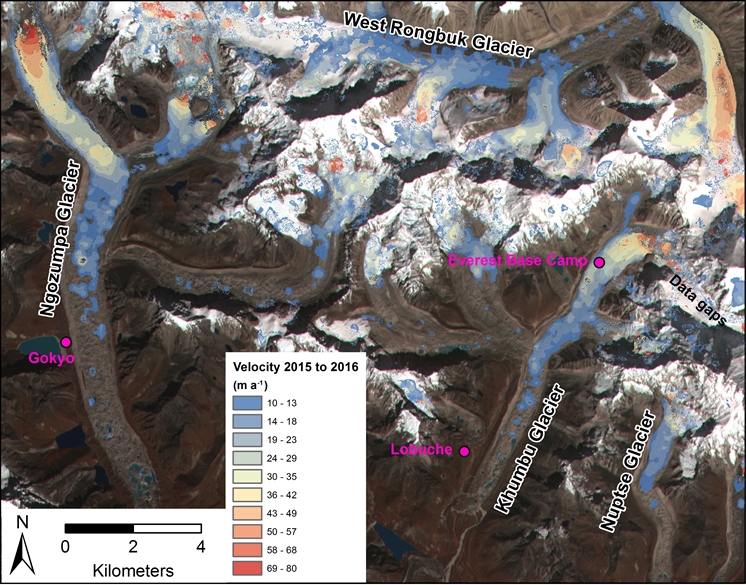
Fig. 3: Surface velocity of glaciers in the Everest region derived from feature tracking on ASTER satellite imagery. [Credit: Scott Watson]
Edited by Sophie Berger
References/further reading
- Bolch, T Buchroithner, MF Peters, J Baessler, M and Bajracharya, S. 2008. Identification of glacier motion and potentially dangerous glacial lakes in the Mt. Everest region/Nepal using spaceborne imagery. Nat. Hazards Earth Syst. Sci. 8: 1329-1340. 10.5194/nhess-8-1329-2008
- King, O Quincey, DJ Carrivick, JL and Rowan, AV. 2017. Spatial variability in mass loss of glaciers in the Everest region, central Himalayas, between 2000 and 2015. The Cryosphere 11: 407-426. 10.5194/tc-11-407-2017
- Pritchard, HD. 2017. Asia’s glaciers are a regionally important buffer against drought. Nature 545: 169-174. 10.1038/nature22062
- Rounce, DR McKinney, DC Lala, JM Byers, AC and Watson, CS. 2016. A new remote hazard and risk assessment framework for glacial lakes in the Nepal Himalaya. Hydrol. Earth Syst. Sci. 20: 3455-3475. 10.5194/hess-20-3455-2016
- Salerno, F Guyennon, N Thakuri, S Viviano, G Romano, E Vuillermoz, E Cristofanelli, P Stocchi, P Agrillo, G Ma, Y and Tartari, G. 2015. Weak precipitation, warm winters and springs impact glaciers of south slopes of Mt. Everest (central Himalaya) in the last 2 decades (1994–2013). The Cryosphere 9: 1229-1247. 10.5194/tc-9-1229-2015
- Watson, CS Quincey, DJ Carrivick, JL and Smith, MW. 2016. The dynamics of supraglacial ponds in the Everest region, central Himalaya. Global and Planetary Change 142: 14-27. http://dx.doi.org/10.1016/j.gloplacha.2016.04.008
 Scott Watson is a PhD student at the University of Leeds, UK. He studies glaciers in the Everest region and specifically the surface interactions of supraglacial ponds and ice cliffs, which act as positive feedback mechanisms to increase glacier mass loss. He also investigates glacial lake hazards and the implications of glacial lake outburst floods.
Scott Watson is a PhD student at the University of Leeds, UK. He studies glaciers in the Everest region and specifically the surface interactions of supraglacial ponds and ice cliffs, which act as positive feedback mechanisms to increase glacier mass loss. He also investigates glacial lake hazards and the implications of glacial lake outburst floods.
Tweets @CScottWatson. Outreach: www.rockyglaciers.co.uk

